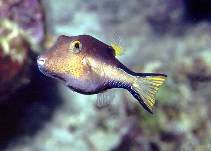| Family: |
Tetraodontidae (Puffers), subfamily: Canthigasterinae |
| Max. size: |
12 cm TL (male/unsexed) |
| Environment: |
reef-associated; marine; depth range 1 - 40 m |
| Distribution: |
Western Central Atlantic: South Carolina, USA and Bermuda to Tobago and the Lesser Antilles. All Canthigaster specimens so far recorded from Madeira belong to Canthigaster capistrata (Ref. 43205). |
| Diagnosis: |
Dorsal spines (total): 0-0; Dorsal soft rays (total): 10-11; Anal spines: 0-0; Anal soft rays: 9-9. Distinguished from all other Atlantic species by a short upper dark longitudinal stripe, presence of few spots on flank and dorsum, and absence of a conspicuous (larger than eye) spot on the dorsum. The upper dark longitudinal stripe extends from caudal-fin dorsal margin to the vertical through dorsal-fin base. Although a horizontal line of dark spots extends anterior to the anterior portion of the horizontal dark stripe in some specimens, and sometimes even surpasses the dorsal fin base, this line of spots never forms a continuous stripe. Also distinguished by the absence of vertically oriented bars on the caudal fin and by the presence of bars on the snout (Ref. 43205). |
| Biology: |
Inhabits reefs and marginal habitats such as seagrass beds (Ref. 43205). Diet consists of seagrass, sponges, crabs and other crustaceans, mollusks, polychaete worms, sea urchins, starfishes, hydroids and algae (Ref. 13442). Monogamous (Ref. 52884). |
| IUCN Red List Status: |
Least Concern (LC); Date assessed: 08 June 2011 Ref. (130435)
|
| Threat to humans: |
harmless |
Source and more info: www.fishbase.org. For personal, classroom, and other internal use only. Not for publication.
